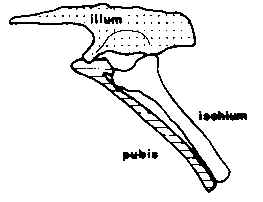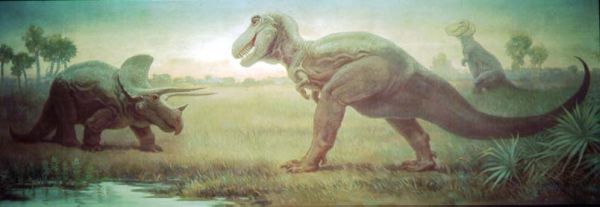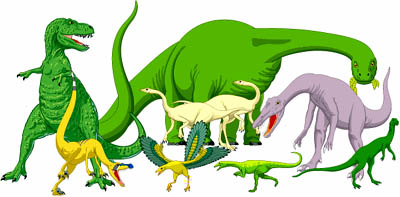Dinosauria
Taxa on This Page
- Dinosauria
- Saurischia
One of the most successful lifeforms to inhabit the surface of the Earth, the dinosaurs dominated all medium to large terrestrial herbivore, omnivore, and carnivore niches and guilds for some 150 million years, were an important component of small terrestrial vertebrate fauna for the same period, as well as including the largest land animals ever to live, as well as being by far the most successful of the three clades of vertebrates that achieved powered flight and by far the most diverse and important aerial vertebrates for 130 odd million years. (yes, birds are dinosaurs, cladistically speaking!) MAK120206
Dinosaur Groups
Traditionally, the dinosaurs were divided into two orders, depending on the structure of the hip bones. Those that had a reptilian-like pelvic bone were put in the Order Saurischia or "lizard-hips"; while the ones with a bird-like pelvic bone made up the Order Ornithischia or "bird-hips". (Paradoxically, it was from "lizard-hipped" and not the "bird-hipped" forms that birds evolved). This classification is still adhered to in some (especially older) popular and academic books, but has pretty much been rejected in favour of the cladistic interpretation.
 The earliest proto-dinosaurs [1] (basal Ornithodira) were a group of small early dinosaur-like archosaurs, known only from a few scrappy Argentinian fossils of Mid-Triassic age. These are neither saurischian nor ornithischian. These creatures, previously considered ornithosuchid thecodonts, are not even formally considered dinosaurs (although they are dinosauromorphs, which means dinosaurs and a few related forms more closely related to dinosaurs then to pterosaurs.). They are the stem forms from among which which the dinosaurs evolved. It has also for some years been felt that they are closely related to the Pterosaurs flying reptiles). There is however a rival theory which derives the pterosaurs from prolacertiform "lizards," or perhaps even more distantly related stock.
The earliest proto-dinosaurs [1] (basal Ornithodira) were a group of small early dinosaur-like archosaurs, known only from a few scrappy Argentinian fossils of Mid-Triassic age. These are neither saurischian nor ornithischian. These creatures, previously considered ornithosuchid thecodonts, are not even formally considered dinosaurs (although they are dinosauromorphs, which means dinosaurs and a few related forms more closely related to dinosaurs then to pterosaurs.). They are the stem forms from among which which the dinosaurs evolved. It has also for some years been felt that they are closely related to the Pterosaurs flying reptiles). There is however a rival theory which derives the pterosaurs from prolacertiform "lizards," or perhaps even more distantly related stock.
 The Saurischia or "lizard hipped" dinosaurs are those more closely related to birds than to Triceratops. Conventionally, they are divided in turn into two groups, one largely carnivorous, the other herbivorous. The first of these are the Theropoda, the bipedal carnivorous dinosaurs, with their bird-like legs and necks. Theropoda means "beast-feet", a rather inappropriate name; "bird(-like) feet" would have been better. Included in this huge and diverse group are both small forms (including the birds themselves) and large predators such as Allosaurus and Tyrannosaurus.
The Saurischia or "lizard hipped" dinosaurs are those more closely related to birds than to Triceratops. Conventionally, they are divided in turn into two groups, one largely carnivorous, the other herbivorous. The first of these are the Theropoda, the bipedal carnivorous dinosaurs, with their bird-like legs and necks. Theropoda means "beast-feet", a rather inappropriate name; "bird(-like) feet" would have been better. Included in this huge and diverse group are both small forms (including the birds themselves) and large predators such as Allosaurus and Tyrannosaurus.
 The other group of Saurischia, the Sauropodomorpha, were herbivores. There are two main subgroups, the Sauropoda the inappropriately named "lizard-feet"), and their ancestors or uncles, the Prosauropoda "before the sauropods"). Although the prosauropods were relatively small, the more advanced types, and all of the sauropods, were elephantine giants with tiny heads, very long necks and tails, massive bodies, and pillar-like legs. This group includes the famous "Brontosaurus" (or Apatosaurus) and its relatives. Like modern-day elephants, they relied on their great size as a defense against carnivores.
The other group of Saurischia, the Sauropodomorpha, were herbivores. There are two main subgroups, the Sauropoda the inappropriately named "lizard-feet"), and their ancestors or uncles, the Prosauropoda "before the sauropods"). Although the prosauropods were relatively small, the more advanced types, and all of the sauropods, were elephantine giants with tiny heads, very long necks and tails, massive bodies, and pillar-like legs. This group includes the famous "Brontosaurus" (or Apatosaurus) and its relatives. Like modern-day elephants, they relied on their great size as a defense against carnivores.
 The Ornithischia ("bird hipped" dinosaurs), or Predentata so called beacuse they posses a unique extra predentary bone in front of the jaw, which served as a sort of beak) were a more diverse group of herbivores. Being much smaller than the sauropods, they survived because they evolved various other means to avoid becoming fast food for their meat-eating theropod contemporaries. The ornithopods, for example, depended on fleetness of foot and acute sight and hearing. The Ceratopsian dinosaurs (Triceratops, etc) were the rhinoceroses of the dinosaur world, their formidable horns at least appear to be ample protection against even the largest and fiercest carnivores. There is a substantial body of opinion that these horns were more decorative than functional -- although we have probably not heard the end of this issue. The Stegosaurs and Ankylosaurs evolved armour plates, spikes, and tail-clubs as defensive and offensive weapons.
The Ornithischia ("bird hipped" dinosaurs), or Predentata so called beacuse they posses a unique extra predentary bone in front of the jaw, which served as a sort of beak) were a more diverse group of herbivores. Being much smaller than the sauropods, they survived because they evolved various other means to avoid becoming fast food for their meat-eating theropod contemporaries. The ornithopods, for example, depended on fleetness of foot and acute sight and hearing. The Ceratopsian dinosaurs (Triceratops, etc) were the rhinoceroses of the dinosaur world, their formidable horns at least appear to be ample protection against even the largest and fiercest carnivores. There is a substantial body of opinion that these horns were more decorative than functional -- although we have probably not heard the end of this issue. The Stegosaurs and Ankylosaurs evolved armour plates, spikes, and tail-clubs as defensive and offensive weapons.
The Ornithischia -- unlike saurischian dinosaurs, reptiles and birds -- possessed mammal-like cheek muscles and cheek pouches to aid in chewing. In this respect they paralleled the mammalian form. Certainly, many Ornithischia filled ecological roles similar to those of the mammalian ungulates.
So we see among the dinosaurs the tendency towards both an avimorphisation or bird-form-tendency in the Theropods, and a theromorphisation or mammal-form-tendency) in the Ornithischia. The dinosaurs of the Mesozoic era in a sense presaged the birds and mammals of the Cenozoic era.
A word now about birds. Most palaeontologists and dino-enthusiasts today also consider the Birds to be a subgroup of dinosaurs. Cladistically (phylogenetically) speaking this is correct: birds evolved from dinosaurs, so if dinosaurs are to retain their monophyletic status they must include birds. MAK010930. Revised ATW050609.
[1] The discussion here assumes a more or less conventional view of archosaur evolution. We are aware of unpublished work which might drastically alter this view. For both scientific and historical reasons, the data sets used to produce the present consensus tree of the archosaurs are weak. Some of those factors are discussed elsewhere. A complete restructuring of archosaur evolution, based on new data, is not at all out of the question.
Descriptions
Dinosauria: Eoraptor. LCA birds & Triceratops.
Range: fr mT.
Phylogeny: Dinosauriformes:
Lagosuchidae+ (Silesauridae + *: Ornithischia+ Saurischia.)
Characters: Ectopterygoid lateral to transverse flange of pterygoid; $ postfrontal absent; $ temporal muscles extend anteriorly onto skull roof; quadrate head laterally exposed; S-shaped neck; dorsal vertebrae shorter; $ at least 3 fully incorporated sacral vertebrae (with 3rd incorporated from dorsal vertebrae); forelimb < 50% length of rear (reversals in several groups); deltopectoral crest extends further down humerus; $ humerus with elongate deltopectoral crest; manus 4 with <4 phalanges; claws on 1-3 only; semi-perforate (usually fully perforated) acetabulum with buttress; brevis shelf on ilium; ischium with obturator process restricted to anterior 1/3rd; $ femur with ball-like head; medial tuberosity of femur reduced; shaft of femur straight or bowed anteriorly; femur vertical; femur has greater, lesser & 4th trochanters; $ tibia with cnemial crest; $ well-developed ascending process of astragalus on anterior face of tibia; $ calcaneum with concave surface for articulation of fibula; metatarsals elongate and function as part of pes.
Discussion: The limiting factor is that muscles contract only about
30% of their length. Increasing muscle length therefore increases motion of the bone.
Tetrapod Model: Simple, tri-radiate structure. Pubis, ileum & ischium meet at Y-shaped junction. Acetabulum located at the junction, and head of femur extends outward at 90° along its long axis. Protraction: Pubis extends antero-ventrally. Muscles insert on femur (pubofemoral) and protract (forward) it . Retraction: Tail (and/or ischium?) extends posteriorly and retract femur (caudofemoral). Abduction: Ileum extends posteriorly and muscles inserting on femur abduct it towards mid-line. Basic Tetrapod pelvis is plate-like. Extensions of pelvic bones are relatively small, and ileum articulates with only 1-2 vertebr ae in sacrum. Muscles to pubis and ischium extend ventrally, countered to some extend by iliofemoral muscles.
ae in sacrum. Muscles to pubis and ischium extend ventrally, countered to some extend by iliofemoral muscles.
The Problem: As the femur rotated downwards to become more vertical, the length of the muscle running from the pubis and ischium shortened relative to the length of the femur.
The Solutions: Open acetabulum with bracing dorsally. Saurischians: extended pubis & ischium and rotated pubis antero-dorsally. Early ornithischians retroverted pubis (parallel to ischium) and protracted femur by attachment to anterior extension of ileum (see image). Later ornithischians secondarily developed an anterior projection of the pubis, as well as retaining the retroverted shaft.
Saurischia: All dinosaurs closer to birds than to Triceratops.
Introduction: The Saurischia or "lizard hipped" dinosaurs are conventionally divided in turn into two groups, one carnivorous, the other herbivorous. The first  of these are the Theropoda, the bipedal carnivorous dinosaurs, with their bird-like legs and necks. Theropoda means "beast-feet", a rather inappropriate name; "bird(-like) feet" would have been better. Included in this huge and diverse group are both small forms (among them the ancestors of birds) and large predators such as Allosaurus and Tyrannosaurus.
of these are the Theropoda, the bipedal carnivorous dinosaurs, with their bird-like legs and necks. Theropoda means "beast-feet", a rather inappropriate name; "bird(-like) feet" would have been better. Included in this huge and diverse group are both small forms (among them the ancestors of birds) and large predators such as Allosaurus and Tyrannosaurus.
 The other group of Saurischia, the Sauropodomorpha, are the herbivores. There are two main subgroups, the Sauropoda the inappropriately named "lizard-feet"), and their ancestors, the Prosauropoda "before the sauropods". Although the primitive prosauropods were relatively small, the more advanced types, and especially all of the sauropods, were elephantine giants with tiny heads, very long necks and tails, massive bodies, and pillar-like legs. This group includes the famous Apatosaurus and its relatives. Like modern-day elephants, they relied on their great size as a defense against carnivores.
The other group of Saurischia, the Sauropodomorpha, are the herbivores. There are two main subgroups, the Sauropoda the inappropriately named "lizard-feet"), and their ancestors, the Prosauropoda "before the sauropods". Although the primitive prosauropods were relatively small, the more advanced types, and especially all of the sauropods, were elephantine giants with tiny heads, very long necks and tails, massive bodies, and pillar-like legs. This group includes the famous Apatosaurus and its relatives. Like modern-day elephants, they relied on their great size as a defense against carnivores.
No contact between maxillary process of premaxilla and nares; $ subnarial foramen; antorbital fenestrae; $ forked post process of jugal; $ jugal overlaps laterally onto lacrimal; temporal musculature extends into frontals; neck elongated & S-shaped; posterior cervical vertebrae elongated; $ axial postzygapophyses lateral to prezygapophyses; trunk vertebrae have accessory articulations; enlarged manus I; metacarpal I short, robust, & has 2 asymmetrical distal condyles so that digit is set off at an angle (the "grasping hand"); manus III longest (hand characters would exclude Herrerasauridae); $ ischium with rod-like shaft; pubis points forward (propubic); wedge-shaped ascending process of astragalus.
Links: anatomy; The Saurischia; Saurischian Dinosaurs - Enchanted Learning Software. 010708.
checked ATW031023, page last modified MAK120301

 The Saurischia or "lizard hipped" dinosaurs are those more closely related to birds than to Triceratops. Conventionally, they are divided in turn into two groups, one largely carnivorous, the other herbivorous. The first of these are the
The Saurischia or "lizard hipped" dinosaurs are those more closely related to birds than to Triceratops. Conventionally, they are divided in turn into two groups, one largely carnivorous, the other herbivorous. The first of these are the  The other group of Saurischia, the
The other group of Saurischia, the 
 ae in sacrum. Muscles to pubis and ischium extend ventrally, countered to some extend by iliofemoral muscles.
ae in sacrum. Muscles to pubis and ischium extend ventrally, countered to some extend by iliofemoral muscles.
 of these are the Theropoda, the bipedal carnivorous dinosaurs, with their bird-like legs and necks. Theropoda means "beast-feet", a rather inappropriate name; "bird(-like) feet" would have been better. Included in this huge and diverse group are both small forms (among them the ancestors of
of these are the Theropoda, the bipedal carnivorous dinosaurs, with their bird-like legs and necks. Theropoda means "beast-feet", a rather inappropriate name; "bird(-like) feet" would have been better. Included in this huge and diverse group are both small forms (among them the ancestors of  The other group of Saurischia, the Sauropodomorpha, are the herbivores. There are two main subgroups, the
The other group of Saurischia, the Sauropodomorpha, are the herbivores. There are two main subgroups, the